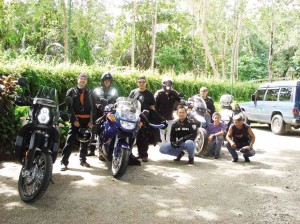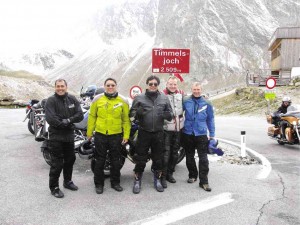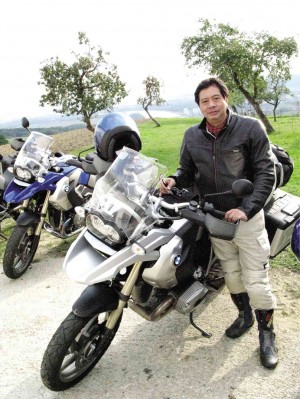CEOs embrace brotherhood of the long, winding road
Why do we ride? Why are so many middle-aged professionals and senior executives buying big bikes, donning armored jackets, slipping into leather gloves and reinforced boots and riding off to Tagaytay, or Subic, or Tanay, or Gumaca at the crack of dawn every Sunday morning?
The easy explanation dismisses it as merely the coming of our second childhood, the fulfillment of juvenile dreams, or simply the performance of male bonding rituals amidst the roar and the swoosh of high performance machines.

STOPPING by Duka Bay Resort in Misamis Oriental on the way to Camiguin Island are the wandering souls, among them (from left) Philip Camara, the author, Pete Cariquitan, Ibba Bernardo, Benjie Luna and Romy Bernardo.
Perhaps. But we riders can attest that there are certainly deeper, more meaningful explanations for the urge to mount our bikes and join the thundering herd on Sunday mornings or on long weekends, as we navigate around the unruly buses, jeepneys, tricycles, dogs, chickens, and pedestrians and finally escape the clutches of the metropolis, coast through the countryside, and still manage to be back home by lunchtime to be with our wife and kids in the afternoon, go to mass at sunset and have a pleasant family dinner after.
And why does big biking have a particular appeal to CEOs, senior executives and industry leaders? Well, to belabor the obvious, while it looks like a highly individualistic sport, one of its biggest attractions is that big biking is actually the pinnacle of team play. Each biker plays a role in the veritable wolf pack—whether playing the “spearhead” or lead rider, or the “sweeper” or rear guard—the singular objective is team security and the safe arrival at the ride destination. Big biking is a team sport. And like any other team sport there are certain fundamental principles that encourage adventurous individuals to choose to learn how to ride.
We can cite at least five reasons why we choose to ride.
Article continues after this advertisementIt’s about time
Article continues after this advertisementThe kids are no longer toddlers and are nearing adulthood. The childbearing and childrearing days are mostly behind us. The house has been set up. We are at or near the summit of our respective professions. The cars are fully paid off. And, lo and behold, there is some surplus in the bank account to purchase, say, a reasonably priced big bike (by definition bigger than 450cc). This is when we realize that the time has come to turn a previous gleam in the eye, and to transform the wistful yearnings of our youth for the freedom of the wide open spaces and the proverbial wind in our face, into the reality of a powerful, throbbing, gorgeous big bike weaving skillfully through the twisties of Bitukang Manok in the Bicol region or climbing Marcos Highway up to the City of Pines or breaching Dalton Pass to access Cagayan Valley.
It is pure wanderlust
During our youthful days, we always suspected that there is a whole, wide, beautiful country out there filled with warm people and incredible vistas. In the course of our work when we were younger, we got bits and pieces of this patchwork tapestry. But after a couple of years of riding, our big bike group has seen and experienced almost the entire tapestry—from the windmills and beaches of Pagudpud via Tuguegarao and the Callao caves, all the way to the seafood markets of General Santos, Cotabato, the durian stalls of Davao, through the Buda highway to the pineapple plantations of Bukidnon and via Ro-Ro to the hot springs and lanzones of Camiguin Island.
And everywhere we went, we were met by smiles, friendly chatter, helpful guides, curious locals eager to lend a hand, or have selfies taken, with the bikes and not the rider! On our part, we are always the anti-stereotypes—the respectful, fun-loving yet courteous visitors, not quite the hooligans and boors bikers are often depicted in the movies. Some Pinoy big bikers have also managed to ride abroad—in South Africa, in Borneo, in Baja, Maxico, in Yosemite, California and in the Austrian Alps and Italian Dolomites. To see all these interesting places and to meet such wonderful people is to appreciate the beauty and majesty of God’s work.

BIKERS (from left) AJ Adiviso, Arthur Tan, the author, Josef Pfister and Jeff Ingram pause at the Timmelsjoch Pass on the Italian-Austrian border.
It is the macho effect
Of course a little vanity is involved here. Wearing leather jackets, gloves and high-cut riding boots (in scorching Manila!) atop gleaming, pricey superbikes conjures adolescent illusions of being Matt Damon (Jason Bourne) or Daniel Craig (James Bond), or in an earlier era, Marlon Brando or Steve McQueen. Big bikes are undoubtedly chick mag nets and every once in a long while, illusion becomes reality. But most of the time, it’s just smoke and mirrors, a juvenile wet dream—like that time in Bacolod when we were surrounded by a gaggle of schoolgirls swooning excitedly at our group and shouting “Power Rangers! Power Rangers!” Ouch. To be mistaken for cartoon characters. That was when reality hits home. And it hurts, just a little bit. But there are also many instances when real men off the streets would ogle and marvel at our machines and our accoutrements. And that’s when we fantasize that we belong to that rare breed of Man, the Adventure Biker, the one-who-rides-and-crosses-mountains-and-seas-in-search-of-Truth-and-Beauty. Cut! End of fantasy.
There is modern technology
The bikes of the 21st century are far superior, technology-wise, compared with the bikes of the ’70s, ’80s and ’90s. The most coveted name brands today have totally upgraded their latest models starting from the design, on to the weight, then the fuel systems and finally the braking systems. In terms of design, aerodynamic configurations reduce drag and allow better handling and safety at higher speeds.
Nearly all big bikes now have fuel injection and hence, are less fuel-thirsty. Big bikes may look bulky and heavy but may actually weigh less due to the extensive use of more carbon fiber, aluminum fairings, titanium exhaust pipes, monoshocks and tubular frames. Again, this adds greater maneuverability, speed and safety. By adopting the ABS (Anti-lock Braking Systems) found in many cars, big bikes now have shorter, yet safer, braking distances and therefore more control to avoid accidents. Because of the greater emphasis on ease of handling and safety, big bike sales are up all over the world. And more adventure bikers are hitting the road.
Brotherhood of the road
Bikers everywhere have this unspoken, unwritten bond, whether on the smallest or on the biggest of bikes. Criminal elements excluded, this compact says that: “We are all part of the Brotherhood of the Road. Our paramount mission is to ensure the Safety and Well-Being of every Biker at all times.” This is a real code. Not some fancy, romantic slogan imbibed during the motorcycle riding course we took prior to our first ride on the superhighway. Once we ride on that saddle and start running and gunning our machines, we all assume a sense of responsibility for all the riders in our group, for our individual selves, and for all the riders we encounter in the course of our trip. This code is true not just in the Philippines but all over the world. When we pass each other on the street, big bikers often offer a slight nod, a honking of the horns, a wave of the hand, to acknowledge a Brother Biker. Like ships on the ocean, when bikers come across an accident, we offer assistance and ensure that the distressed biker gets proper help. Off the road, bikers often get together at local clubs to discuss bike equipment, to swap stories on new and old trips and to make new friends. This Brotherhood of the Road is a remarkable phenomenon amidst the turbulence and complexities of our modern society.
How does one become a Big Biker? Without sounding snooty or snobbish, big biking is not for everyone. As with any other hobby or occupation, big biking demands a unique and high level of innate or inborn skill, proper and continuous training, and long riding hours before one can take to the highway plus that enduring and irreplaceable quality called PASSION.

THE AUTHOR on the border of Austria and the Czech Republic, with the river Danube in the background.
When I summoned the courage to get started, this rider bought two bikes—one a trainer and the other the coveted Machine. I took two short riding courses and then for nearly every weekend for six months, I would take riding loops around C-5, Edsa, Roxas Boulevard, Binondo and Quezon Boulevard—sweating profusely, jostled roughly by the small bikes we call the “underbones,” harassed by buses, jeeps, taxis and dogs, until finally, bravely, after six months, the trainer bike is resold and the big bike is taken out of hibernation. And that first ride on the North Expressway is taken. A surge of mixed emotions kicks in and tears of joy and fear flow. At long last, another dream on the bucket list is fulfilled.
For all these reasons, riding has become a passion for many, an oasis of peace, brotherhood, and beauty, amidst the stresses and pressures of everyday living. Big bike riding provides what Ian Fleming calls our “quantum of solace.”
Because every time we ride, it’s just us, the bike, the road, and about a hundred million personal thoughts between the start of our journey and our final destination.
(The author is president and COO of SMC Global Power. The 60-year-old also served as COO of the Development Bank of the Philippines.)
